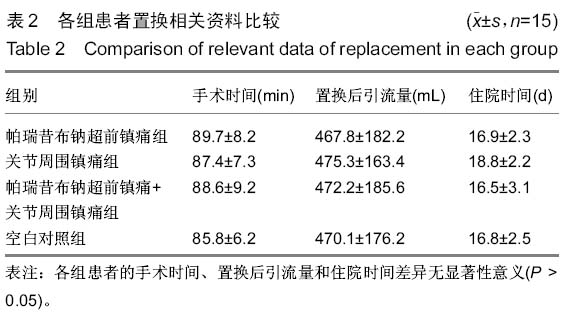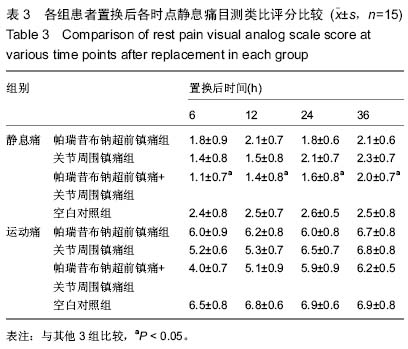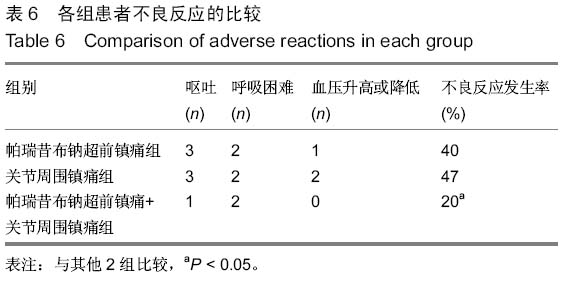| [1] 张俊,蒋壶,邵俊杰,等.人工全膝关节置换术中关节周围注射镇痛药物对置换后痛的效果[J].中国组织工程研究与临床康复,2007, 43:8678-8682.
[2] 张亚丽,谢秀霞,闫淑霞.人工全髋关节置换术围置换期患者的护理[J].中国医药导报,2007,4(29):61-62.
[3] Frehill B, Crocombe AD, Agarwal Y, et al. Finite element assessment of block-augmented total knee arthroplasty. Comput Methods Biomech Biomed Engin. 2015:18(15): 1726-1736.
[4] 梁晓燕,陆皓,蒋建芳.超前多模式联合镇痛在人工膝关节置换置换后关节功能恢复的效果观察[J].创伤外科杂志,2015,17(3); 269-270.
[5] 钱霄,瞿玉兴,蒋涛.股神经和硬膜外自控镇痛在全膝关节置换后的作用[J].中国组织工程研究与临床康复,2011,15(17):318-320.
[6] 李永明,吕涛.围手术期多模式复合镇痛对膝关节置换患者血流变及粘附因子水平的影响[J].宁夏医科大学学报,2014,36(8): 901-903.
[7] Trueblood A, Manning DW. Analgesia following total knee arthroplasty. Curr Opin Orthop. 2007;18:76-80.
[8] Nwachukwu BU, Bozic KJ, Schairer WW, et al. Current status of cost utility analyses in total joint arthroplasty: a systematic review. Clin Orthop Related Res. 2015;473(5):1815-1827.
[9] 尹东,黄宇,莫冰峰,等.环氧化酶-2抑制剂在膝关节置换围手术期镇痛及功能康复的作用[J].中华关节外科杂志(电子版),2014, 8(2):171-174.
[10] Parvizi J, Miller AG, Gandhi K. Multimodal pain management af tertotal joint arthmplasty.J Bone Joint Surg Am. 2011;93(11): 1075-1084.
[11] 陈江湖,李坚,王东信.小剂量氯胺酮联合吗啡用于老年人膝关节置换后镇痛治疗效果观察[J].中华老年医学杂志,2013,32(12): 1322-1325.
[12] 贺葵,申利英,郭雪梅.疼痛管理对全膝关节置换患者置换后疼痛及恢复的影响[J].实用临床医药杂志,2015,19(6):135-137.
[13] Ilfeld BM, Mariano ER, Madison SJ, et al. Continuous femoral versus posterior lumbar plexus nerve blocks for analgesia after hip arthroplasty: a randomized, controlled study. Anesth Analg. 2011;113(4):897-903.
[14] 吴昉,刘功俭,谭迎春.帕瑞昔布和右美托咪定在全膝关节置换术的超前镇痛效果比较[J].徐州医学院学报,2013,33(6):402-406.
[15] Bourne MH. Analgesics for orthopedic postoperative pain. Am J Orthop (Belle Mead NJ). 2004;33(3):128-135.
[16] 张庭,王睿铸,胡燕军,等.目测类比评分法在全膝关节置换术镇痛后应用体会[J].现代生物医学进展,2011,11(22):4362-4363.
[17] Buvanendran A, Kroin JS. Multimodal analgesia for controlling acute postoperative pain. Curr Opin Anaesthesiol. 2009;22(5):588-593.
[18] Fu PL, Xiao J, Zhu YL, et al. Efficacy of a multimodal analgesia protocol in total knee arthroplasty:a randomized, controlledtrial. Int Med Res. 2010;38(4):1404-1412.
[19] 赵宏,黄志峰,邱贵兴,等.全膝关节置换后不同镇痛方法效果的比较[J].中国临床康复, 2005;9(18):12-13.
[20] 雷昌斌,王东,陈占昆,等.利多卡因对关节软骨培养模型中软骨细胞活性的影响[J].中国骨与关节杂志,2013,6(3):167-170.
[21] 侯蕾娜,宋凤香,朱晗月,等.连续股神经阻滞超前镇痛对老年患者全膝关节置换术置换后早期认知功能的影响[J].国际麻醉学与复苏杂志,2015,36(6):488-492.
[22] Szczukowski M, Hines JA, Snell JA, et al. Femoral nerve block for total knee arthroplasty patients:a method to control postoperative pain. Arthroplasty. 2004;19(6):720-725.
[23] 马璐璐,任立英,黄宇光.人工膝关节表面置换术患者置换后镇痛效果调查[J].基础医学与临床,2015,35(5):680-683.
[24] 卫琰,朱刚,周晓鸣,等.帕瑞昔布钠超前镇痛对下肢骨科手术止血带疼痛控制的影响[J].中国疼痛医学杂志,2012,18:59-60.
[25] 赖露颖,许睿,徐世元.全膝关节置换置换后镇痛治疗的研究进展[J].国际麻醉学与复苏杂志,2015,36(5):443-446.
[26] 吴新民,岳云,张利萍,等.置换后镇痛中帕瑞昔布钠对吗啡用量的节俭作用和安全性、前瞻性、多中心、随机、双盲、安慰剂对照、平行分组研究[J].中华麻醉学杂志,2007,27(1):7-10.
[27] 廖天成,吕波.多模式镇痛在人工全膝关节置换术的应用现状[J].实用医院临床杂志,2015,12(3):180-182.
[28] 王超,刘明廷,戚大春,等.全膝关节置换围手术期两种镇痛方案的比较[J].中国矫形外科杂志,2015,23(9):789-793.
[29] Sinatra RS, Jahr JS, Reynolds LW, et al. Efficacy and safety of singleand repeated administration of 1 gram intravenous acetaminopheninjection (paracetamol) for pain management after major orthopedic surgery. Anesthesiology. 2005;102(4): 822-831.
[30] 邴淼,叶伟光.超声引导连续股神经阻滞用于老年患者膝关节置换置换后康复镇痛的临床观察[J].蚌埠医学院学报,2015,40(3); 351-354.
[31] 杨扬,屠伟峰,邓丽珍,等.帕瑞昔布钠不同方式预先给药对神经病理性疼痛大鼠行为学的影响[J].广东医学,2014,(12): 1809-1813.
[32] Rawal N, Allvin R, Axelsson K, et al. Patient-controlled regional analgesia (PCRA) at home: controlled comparison between bupivacaine and ropivacaine brachial plexus analgesia. Anesthesiology. 2002;96(6):1290-1296.
[33] 钟宝琳,李优春,黄桂明,等.预注帕瑞昔布钠对腹腔镜胆囊切除术患者置换后疼痛及炎性因子和应激反应的影响[J].中国老年学杂志,2012,32(10):2034-2036.
[34] Rivera-Arconada I, Roza C, Lopez-Garcia JA. Spinal Reflexes and Windup In Vitro: Effects of Analgesics and Anesthetics. CNS Neurosci Ther. 2015.
[35] Matson DJ, Hamamoto DT, Bregman H, et al. Inhibition of Inactive States of Tetrodotoxin-Sensitive Sodium Channels Reduces Spontaneous Firing of C-Fiber Nociceptors and Produces Analgesia in Formalin and Complete Freund's Adjuvant Models of Pain. PLoS One. 2015;10(9):e0138140.
[36] Brown JD, Saeed M, Do L, et al. CT-guided injection of a TRPV1 agonist around dorsal root ganglia decreases pain transmission in swine. Sci Transl Med. 2015;7(305): 305ra145.
[37] Elsharkawy H, Maheshwari A, Farag E, et al. Development of technologies for placement of perineural catheters. J Anesth. 2015.
[38] Deba F, Bessac BF. Anoctamin-1 Cl(-) channels in nociception: activation by an N-aroylaminothiazole and capsaicin and inhibition by T16A[inh]-A01. Mol Pain. 2015; 11(1):55.
[39] Kirksey MA, Haskins SC, Cheng J, et al. Local Anesthetic peripheral nerve block adjuvants for prolongation of analgesia: a systematic qualitative review. PLoS One. 2015;10(9): e0137312.
[40] Iannitti T, Graham A, Dolan S. Adiponectin-Mediated Analgesia and Anti-Inflammatory Effects in Rat. PLoS One. 2015;10(9):e0136819.
[41] Golder FJ, Dax S, Baby SM, et al. Identification and Characterization of GAL-021 as a Novel Breathing Control Modulator. Anesthesiology. 2015. |






Lb.jpg)